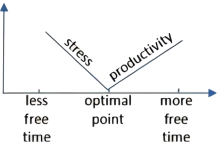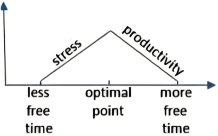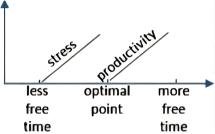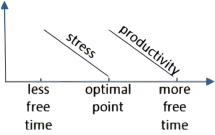1 . The brain function of very late risers and “morning larks(早睡早起的人)” during the hours of the working day is different, according to a study.
Researchers scanned the brains of night owls(夜猫子)with a bedtime of 02: 30 and awake time of 10: 15, along with early risers. The tests performed between 08 : 00 and 20 : 00 found night owls had less connectivity in brain areas linked to keeping consciousness. They were more likely to be scatterbrained and they also had slower reactions and increased sleepiness.
Scientists took 38 people who were either night owls or morning larks (people who went to bed just before 23 : 00 and woke at 06 : 30) and studied their brain function at rest. The volunteers then carried out a series of tasks at various times, from 08 : 00 to 20 : 00, and were asked to report on their levels of sleepiness.
Morning larks were least sleepy and had their fastest reaction time in the early morning tests. They were also found to perform significantly better at this time than night owls. In contrast, night owls were least sleepy and had their fastest reaction time at 20 : 00, although they did not do significantly better than the larks at this time.
The brain connectivity in the areas that predicted better performance and lower sleepiness was significantly higher in larks at all time points, suggesting connectivity in late risers is impaired(减弱的) throughout the whole working day, researchers said.
The lead researcher, Dr Elise Facer-Childs, of the University of Birmingham’s Centre for Human Brain Health, said the findings “could be partly driven by the fact that night owls tend to compromise throughout their lives.” He added, “Night owls during school have to get up earlier, then they go into work and they have to get up earlier, so they’re constantly in conflict.”
Therefore, Dr Facer Childs called for more researches to understand the effects of night owls performing on a work or school schedule to which they are not naturally suited.
1. Which of the following can replace the underlined word “scatterbrained” in Paragraph 2?| A.Unfocused. |
| B.Satisfied. |
| C.Recognized. |
| D.Discovered. |
| A.Morning larks were more tired in the morning. |
| B.Night owls were more active in the morning. |
| C.Morning larks perform better all day. |
| D.Night owls perform better all day. |
| A.The workings of their brain. |
| B.The effects of their compromises. |
| C.Whether they can turn into morning larks. |
| D.How to help them adapt to the normal schedule. |
| A.To solve a problem. |
| B.To give practical advice. |
| C.To tell an interesting story. |
| D.To present a research result. |
2 . There are plentiful ways to help increase your efficiency.
Clarify actual expectations. When you take on a significant task, talk with key participants about what they expect. Perhaps they need a PowerPoint deck; perhaps they don’t.
Develop templates (模板) and checklists. To speed up your process on routine items, come up with a template or checklist. You might want templates for activities like putting together reports or presentations. Checklists are valuable for weekly planning or other repeated activities.
Time box your work. Finally, a strategy for doing a good job faster is deciding how much time you will spend on a task, and them sticking to it. If you tend to overinvest in the research stage, you may want to tell yourself you have to stop after one to two hours. Time boxing doesn’t guarantee you’ll finish the work in the assigned time.
| A.Make it a conversation. |
| B.Communicate with others in time. |
| C.However, it can definitely help with focus. |
| D.It means you spend less time and still do a good job. |
| E.Which strategies work best vary from person to person. |
| F.Both will save you time on remembering or deciding what to do. |
| G.Maybe a comprehensive plan is required or just an outline will work. |
3 . Up and down the economic ladder, many Americans who work—and especially those raising kids—are pressed for time, wishing they had more of it to devote to leisure activities (or even just sleeping). At the same time, research has indicated that people who are busy tend to be happier than those who are idle, whether their busyness is purposeful or not.
A research paper released late last year investigated this trade-off, attempting to pinpoint (精确指出) how much leisure time is best. Its authors examined the relationship between the amount of “discretionary time” people had—basically, how much time people spend awake and doing what they want—and how pleased they were with their lives.
The paper, which analyzed data covering about 35,000 Americans, found that employed people’s ratings of their satisfaction with life peaked when they had in the neighborhood of two and a half hours of free time a day. For people who didn’t work, the optimal (最佳) amount was four hours and 45 minutes.
The research traced a correlation (关联) between free time and life satisfaction, but didn’t provide any definitive (最后的) insight into what underlies that correlation—“which is exciting, because this is a work in progress,” says Cassie Mogilner Holmes, a professor at UCLA’s Anderson School of Management and a co-author of the paper, which hasn’t yet been peer-reviewed or published in an academic journal.
An experiment that the researchers arranged hinted at (暗示) a possible explanation of the correlation they found. They asked participants to picture and describe what it would be like to have a certain amount of daily free time, and then report how they’d feel about that allotment (分配). “What we find is that having too little time makes people feel stressed, and maybe that’s obvious,” says Holmes. “But interestingly, that effect goes away—the role of stress goes away—once you approach the optimal point.” After that point, Holmes says, the subjects started to say they felt less productive overall, which could explain why having a lot of free time can feel like having too much free time.
It’s not clear what an individual is to do with these findings, since the amount of free time people have usually has something to do with a variety of factors, such as having children or a degree of control over work schedules. Holmes shared her research with the MBA students in her class on happiness, and some of the most time-crunched among them were comforted by the findings: “I think that two and a half hours creates a nice goal that even if you increase a little bit more of your discretionary time use, you can expect that it will translate into greater life satisfaction.”
1. According to the passage, what happens to Americans occupied with their work?| A.They allow themselves more leisure time. |
| B.They keep themselves busy on purpose. |
| C.They know how much leisure time is best. |
| D.They experience higher level of satisfaction. |
| A.Researchers have cast light on the cause of the correlation. |
| B.Unemployed people need more leisure time to feel content. |
| C.The paper on the correlation has achieved peer recognition. |
| D.Employed people enjoy more leisure time in the neighborhood. |
A. | B. |
C. | D. |
| A.Holmes is optimistic about the influence of her findings |
| B.individuals are encouraged to control their work schedules |
| C.people with tight schedules can’t benefit from the findings |
| D.the MBA students find no free time to obtain life satisfaction |



